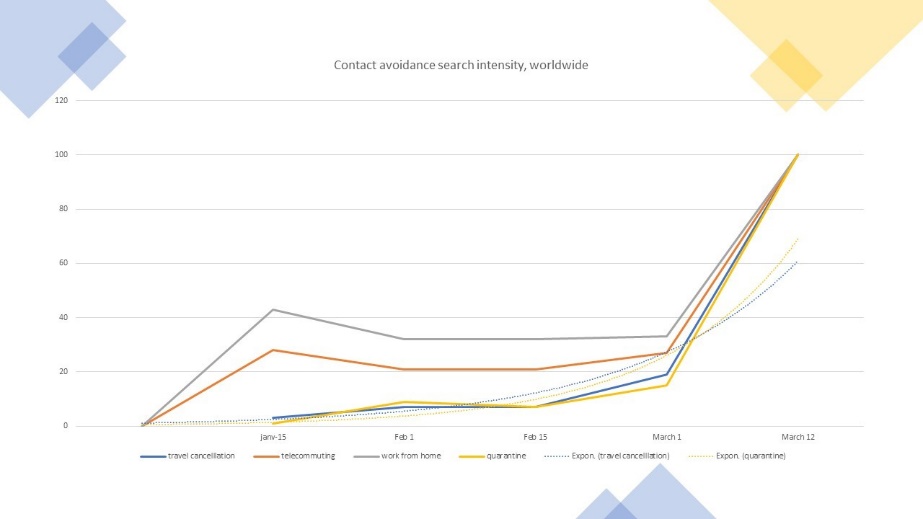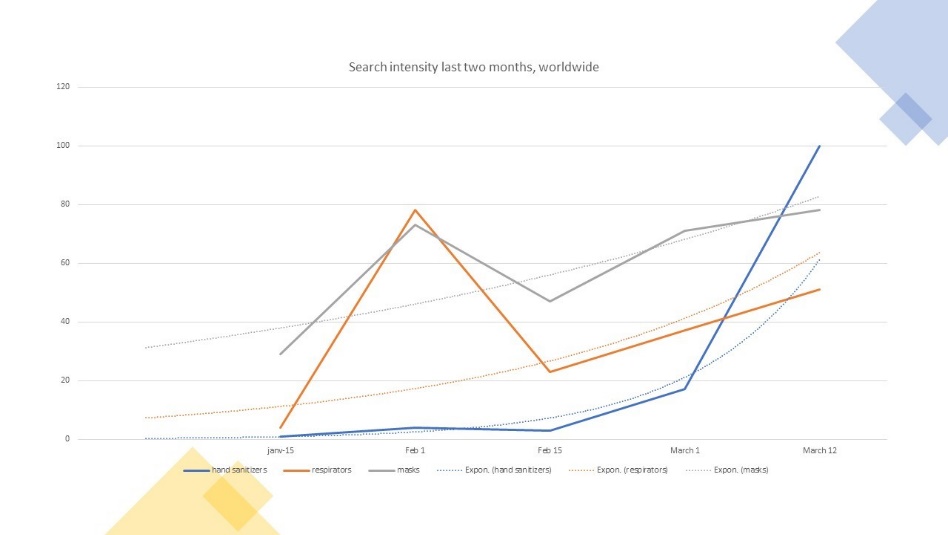People do react to the COVID-19 pandemic: nowcasting behavioural changes through Google searches
-
-
-
-
J. Bughin
Dr Jacques Bughin, UN consultant, Solvay Business School ULB, Portulans Institute and G20Y, former Director McKinsey Global Institute, and senior partner McKinsey & Company.
-
Nowcasting coronavirus cases via Google searches: A strong positive correlation
-
COVID-19 pandemic may spread over 2 quarters worldwide, and everyone can fix it like the Chinese
1. Introduction
March 14
Clearly, as figure 1 demonstrates from recorded data collected by the CDC, we are in an inflexion point in terms of the COVID-19 pandemic. Since 5 days ago , we have surpassed the positive linear trend of new daily cases, and even we got up to 10,000 new cases in one day yesterday, as the virus extended its spread across the globe, and accelerated its diffusion in Europe, including Spain, Italy, but also Germany, France, Benelux and Scandinavia.
Figure 1: How reported new cases have evolved during the COVID-19 outbreak

We mentioned that it is crucial that people adapt behaviour significantly and quickly in the absence of a powerful epidemiologic response, and that a set of simple measures must be applied by all of us to better flatten the curve of the pandemic. The set of behaviours were discussed in previous articles (available here), and include washing hands with soap, wearing masks so as to protect themselves during social contacts, as well as limiting contacts through more remote work, lower travel etc. But are people really doing it? On the optimistic side, case studies on the first wave of the virus hitting China seems to suggest that people are taking the necessarily steps, but on the pessimistic side, this possibly was often because of enforced policies by the Chinese authorities.
Here, we review the evidence by looking at Google trends, under the tested assumption that online searches are powerful markers of awareness and call to actions, and thus « nowcast » behavioural changes.1
2. Nowcasting coronavirus cases via Google searches: A strong positive correlation
Figure 2 provides a plot of new COVID-19 cases from CDC statistics, and google intensity searches linked to the term coronavirus, for the period 23/01/2020 to 13/3/2020.2
Figure 2: Google coronavirus search intensity and new contaminated cases

The correlation is large and positive with a contemporaneous value of 0.65, demonstrating some nowcasting evidence, which we wish to leverage for answering our question as to how people behave in function of the pandemic. We also have tested how the correlation evolves with time lags, and the correlation is actually higher between search intensity, 2 days ahead of new cases, at 0.7, but declines quickly with 5 days ahead. Correlation between new cases ahead of search intensity is also lower, one day ahead at 0.6, two days ahead at 0.45, suggesting that Google searches might possibly be informative slightly ahead of time, even if there is clearly as well some online search reactions to news of new infected cases.3
Given this positive correlation, what can we find in terms of Google trends? Here are the findings:
3. COVID-19 pandemic may spread over 2 quarters worldwide, and everyone can fix it like the Chinese
We first look at how search intensity vary per country/region (see Figure 3), bringing a few important insights.
Figure 3: Search intensity re coronavirus - difference by country/region

-
First, the digital awareness started roughly between Jan 18 to Jan 25, at the time people got noticed of the virus spreading in China, and the lockdown imposed by the Chinese authorities.
-
Second, one sees clearly the geographical waves of the virus. First, China (with searches peaking by Jan 25), then Italy (and Japan by end of February), and now exploding in the US by latest data available, March 12 (The same is true for worldwide searches, in general).
-
Third, slightly worrisome, February went into searches standstill, and only search intensity rebounded by end of February, when the world realized that the virus was going global.
-
Last, but not least, Italy witnessed a rebound in search lately (when the country extended its policies from the North to all the country), and searches remain high in countries like China or Japan, meaning that awareness and worries remain high.
If one uses the correlation from above as a way to anticipate the evolution, we might conjecture that :
-
China seems to come to very limited new COVID-19 cases by now, or roughly 6 weeks after peak searches.
-
We do not know whether we have peaked in search intensity worldwide, but, assume conservatively that we have, this would mean that we are at least 6 weeks at minimum, away to stop (the concern) of the epidemic. This sends us at least to the beginning of May for a possibly control of the disease.
-
We of course may be optimistic here - we do no know whether effective containment will work out and be applied elsewhere. In particular, we are really at the start (or in absent knowledge) of epidemic evolution in continents like Africa and Latin America. In that respect, Latin America search intensity in the last 7 days is roughly at 10% of the worldwide search intensity—this level seems to be the frequency of searches of the world seen by Feb 1 and then back at Feb 22, or at least one month to 6 weeks ago. Adding this to the time line, Latin America may not be finishing its pandemic before June then.
We thus might conjecture that the pandemic will last at least 6 months; thus, roughly more than half a year round, if China as a becnhmark is used and successfully executed (but there is a good chance, it won’t be as rapid).
4. People are (but slowly) getting ready to act
The hypothesis we have is that awareness will lead to appropriate actions by citizens. We find that there has been a significant increase in terms of searching for the risks linked to the COVID-19, and that the number of protective actions may look like growing if searches are a solid nowcasting of people behaviour.
Towards awareness: active searches of risks and symptoms associated with COVID-19
Table 1 provides a snapshot of search intensity in terms of infection and fatality rates, as well as coronavirus symptom searches. They clearly reflect the profile of intensity of coronavirus general searches, with significant positive correlation.
Other search terms (not included here) include Wuhan, MERS, CDC, Jon Hopkins University (reporting cases real time), or pandemic, but the health terms below become more intense and more positively correlated with new cases of the coronavirus, suggesting that people are actively trying to inform themselves on the risk linked to the virus.
Table 1: Health search term linked to COVID-19
| Google Searches | Jan 15 | Feb 1 | Feb 15 | Mar 1 | Mar 12 |
|---|---|---|---|---|---|
| Fatality rate | 0 | 24 | 7 | 38 | 100 |
| Infection rate | 1 | 29 | 13 | 25 | 100 |
| Symptoms | 1 | 22 | 16 | 31 | 100 |
| Coronavirus | 1 | 12 | 6 | 26 | 100 |
Source: Google Trends, worldwide.
Towards possible actions - protective tools and contact avoidance searches linked to COVID-19
Greater awareness should lead to actions. We are especially interested in protective actions people may perform, linked to buying masks, etc, and linked to limiting contacts. We find the good news that people are active searching, indeed (see Figures 4a and 4b). There is an exponential growth in contact avoidance, with an exponential growth through times linked e.g. to quarantines. Likewise, hand sanitizers searches, masks, etc are search terms with strong growth.
Figure 4a and b: Search intensity re coronavirus protection


All the above suggests that people are moving into the right direction in terms of behaviour. Of course, we do not know whether searches lead to actions; further search intensity is a relative term, and we do not know if people buy and apply protective measures sufficiently and well. Time will tell, but this is why we might need incentives, coaching, and possibly enforcement policies to curb the pandemic.
© Jacques Bughin. Written March 14. Comments more than welcome. All errors are mine. References listed as they are found in the text.
-
See Choi and Varian, 2009, Predicting the present with Google trends, Technical report. ↩
-
We took out 13/2 data point as there was a significant change in how cases were reported on that day by Chinese authorities, the by then largest country under attack by the COVID-19. ↩
-
P.S.: technically, we should do some predictive modelling to confirm this matter, but this is out of scope here. ↩